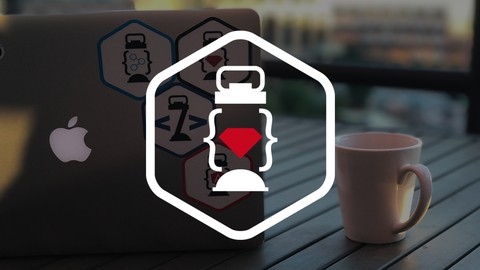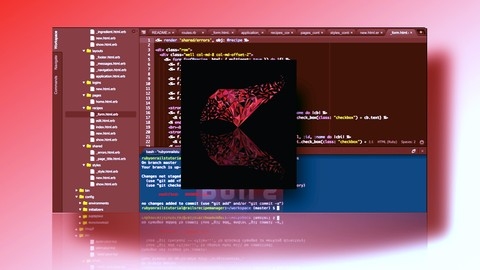Ruby is a versatile and popular programming language known for its elegance and readability.
It’s widely used in web development, data science, and automation, making it a valuable skill for aspiring programmers and experienced developers alike.
Learning Ruby opens doors to exciting career opportunities and allows you to build powerful applications.
Finding the right Ruby course on Udemy can be challenging with so many options available.
You’re looking for a program that provides a comprehensive foundation in Ruby, teaches you how to write clean and efficient code, and prepares you for real-world projects.
For the best Ruby course overall on Udemy, we recommend Learn to Code with Ruby, a comprehensive and beginner-friendly course that covers all the essential concepts of the Ruby language.
This course is taught by a seasoned developer and includes practical exercises and projects to solidify your understanding.
While Learn to Code with Ruby is our top pick, Udemy offers a diverse range of courses tailored to different learning styles and goals.
Keep reading to explore our recommendations for beginners, intermediate learners, and experts, as well as courses focused on specific Ruby frameworks and applications.
Learn to Code with Ruby
You’ll start by learning how to set up your development environment and write your first Ruby programs.
The course covers fundamental programming concepts like variables, data types, methods, and control flow structures.
From there, you’ll dive into more advanced topics like arrays and hashes, which are essential data structures in Ruby.
The course teaches you how to create, manipulate, and iterate over arrays and hashes using various methods and techniques.
You’ll also learn about blocks, procs, and lambdas, which are powerful features in Ruby that allow you to write more expressive and concise code.
The course covers the differences between these constructs and how to use them effectively.
Object-oriented programming is a crucial aspect of Ruby, and the course dedicates several sections to teaching you how to create and work with classes.
You’ll learn about inheritance, which allows you to create specialized classes based on existing ones, and modules, which provide a way to organize and share code across classes.
The course also covers more specialized topics like sets, datetimes, regular expressions, and exceptions.
You’ll learn how to work with these concepts and how they can be applied in real-world programming scenarios.
Additionally, the course introduces you to testing with Minitest, a popular testing framework in Ruby.
You’ll learn how to write tests for your code, which is an essential practice for writing maintainable and bug-free software.
The syllabus also covers reading and writing documentation, which is crucial for collaborating with other developers and maintaining your codebase over time.
You’ll learn how to use RDoc, a tool for generating documentation from Ruby source code.
Finally, the course touches on Ruby gems, which are packages of reusable code that you can easily install and use in your projects.
You’ll learn how to find, install, and use gems, which can save you a lot of time and effort when building applications.
Comprehensive Ruby Programming
You’ll start with the basics of Ruby syntax, variables, and data types like strings and numbers.
As you progress, you’ll dive into more advanced concepts such as methods, iterators, loops, and collections like arrays and hashes.
The course also covers essential programming concepts like conditionals and error handling, equipping you with the skills to write robust and error-free code.
You’ll learn about regular expressions, a powerful tool for text manipulation and pattern matching.
Object-Oriented Programming (OOP) is a crucial aspect of Ruby, and the course provides a comprehensive introduction to OOP principles, including inheritance, polymorphism, and modules.
You’ll also learn how to work with the file system in Ruby, allowing you to create, read, and manipulate files programmatically.
One of the strengths of Ruby is its extensive ecosystem of gems (libraries), and the course covers how to use and research gems effectively.
Metaprogramming, a powerful feature of Ruby that allows you to write code that writes code, is also covered in depth.
The course explores web development with frameworks like Sinatra and Ruby on Rails, enabling you to build web applications.
You’ll also learn how to work with APIs, a crucial skill for integrating external services into your applications.
Algorithms are a fundamental part of programming, and the course includes implementations of various sorting algorithms and solutions to Project Euler problems, helping you develop problem-solving skills.
Additionally, the course touches on big data analysis in Ruby, introducing you to techniques like decision trees.
You’ll also learn about useful tools like the IRB console, Ruby hashes, and CLI tools, enhancing your Ruby development experience.
Testing Ruby with RSpec: The Complete Guide
You will start by setting up your development environment and installing the necessary tools like RSpec and Visual Studio Code.
Next, you will dive into the fundamentals of Test-Driven Development (TDD) and learn how to use RSpec’s core methods like describe, it, expect, and eq.
As you progress, you will learn how to read and fix failing tests, reduce duplication in your test code using techniques like before hooks, helper methods, and the let method.
The course covers advanced topics like nested logic, custom error messages, and using RSpec’s built-in matchers like eq, eql, equal, be, change, contain_exactly, have_attributes, include, start_with, end_with, raise_error, respond_to, and satisfy.
You will also learn how to use the not_to method and write compound expectations.
One of the key areas covered is mocking and stubbing with RSpec.
You will learn how to create test doubles, set up mocks, use the allow method, match arguments, create instance and class doubles, and work with spies.
Throughout the course, you will work on practical examples and exercises to reinforce your understanding of the concepts.
There are also quizzes to test your knowledge along the way.
Ruby Programming For Everyone
The course starts by covering the fundamentals of Ruby programming, ensuring you have a solid foundation.
You’ll learn how to install the necessary tools like Sublime and Git Bash, as well as Ruby itself.
From there, you’ll dive into writing your first “Hello World” program and explore concepts like printing to the screen, string manipulation, variables, and getting user input.
The course then progresses to intermediate topics, where you’ll work with arrays, loops (both while and each loops), and hashes.
You’ll even build the classic FizzBuzz program, which is a great exercise for solidifying your understanding of control flow and logic.
Methods are also covered in-depth, giving you the ability to write reusable code.
As you advance, the course delves into the world of Ruby classes.
You’ll learn how to create classes, define getters and setters, and even add methods for calculating perimeter and area.
The attr_accessor concept is introduced, simplifying the process of creating getters and setters.
Additionally, you’ll learn how to create a draw method, which can be incredibly useful in various applications.
Throughout the course, you’ll be working with practical examples and exercises, ensuring that you not only understand the concepts but also gain hands-on experience in applying them.
Ruby Programming for Beginners
This course starts with the basics, guiding you through strings, objects, and methods in a step-by-step manner.
You’ll learn how to create classes and objects, understand class hierarchies, and work with attribute accessors and class variables.
As you progress, you’ll dive into arrays and hashes, which are fundamental data structures in Ruby.
The course covers loops, iterators, and blocks, enabling you to write more complex programs.
You’ll also learn about conditional statements and boolean operations, essential for controlling program flow.
Moving forward, you’ll explore modules and mixins, which are powerful concepts in Ruby for code organization and reusability.
The course touches on constants, variables, and file handling with YAML, a data serialization format.
Notably, the course includes hands-on sessions and quizzes to reinforce your understanding.
It also provides resources for setting up your development environment on a Mac, including tips for opening a Terminal in any folder.
Beyond the basics, you’ll get a glimpse of Ruby on Rails, a popular web application framework written in Ruby.
The course offers additional resources on topics like file operations, recursion, symbols, and even an adventure game project to apply your newfound skills.
Advanced Ruby Programming: 10 Steps to Mastery
You’ll start by revisiting fundamental concepts like strings, numbers, classes, and objects, solidifying your foundation.
From there, the course dives into more complex areas like class hierarchies, attributes, and class variables, giving you a firm grasp of Ruby’s object-oriented nature.
The syllabus covers essential topics like arrays, hashes, loops, and iterators, empowering you to work effectively with collections and control flow.
You’ll also explore conditional statements, methods, argument passing, and return values, enabling you to write robust and modular code.
Exception handling is a crucial aspect of any programming language, and this course dedicates a section to it, teaching you how to gracefully recover from errors.
Additionally, you’ll delve into blocks, procs, and lambdas, powerful constructs that enable functional programming in Ruby.
It covers symbols, a unique Ruby feature that enhances performance and memory efficiency.
You’ll also learn about threads and fibers, essential for writing concurrent and parallel programs.
Modules and mixins are explored in-depth, allowing you to leverage Ruby’s powerful code reuse mechanisms.
The syllabus also covers file handling, YAML, and Marshal, equipping you with the skills to work with various data formats.
Regular expressions, a powerful tool for text processing, are covered extensively, enabling you to extract and manipulate data with ease.
The course even touches on dynamic Ruby and metaprogramming, showcasing the language’s flexibility and extensibility.
Interestingly, the course also explores the connections between Ruby and Smalltalk, a pioneering object-oriented language that influenced Ruby’s design.
This unique perspective will broaden your understanding of Ruby’s roots and philosophy.
Ruby For Programmers
The course starts by introducing you to Ruby Fundamentals, giving you a quick overview of the Ruby Programming Language.
It provides essential resources and a cheatsheet to get you started with downloads.
You’ll dive into working with Strings, a core data type in Ruby.
The course covers string manipulation techniques with examples and a dedicated cheatsheet.
Next, you’ll learn about Object Orientation in Ruby.
This includes understanding Classes and Objects, as well as Class Variables and Class Methods.
A cheatsheet summarizes the key concepts.
The course then explores Modules and Attributes (also known as Properties).
You’ll learn how to use Modules as mixins to share behavior across classes.
Another cheatsheet reinforces these topics.
Arrays and Hashes, two fundamental data structures in Ruby, are covered next.
You’ll learn how to work with arrays and hashes, manipulate them, and access their elements efficiently.
A combined cheatsheet helps solidify your understanding.
Moving on, you’ll dive into Loops and Iterators in Ruby.
The course teaches you simple loops like while, until, and loop constructs.
A dedicated cheatsheet summarizes the different loop types.
The course also covers Blocks and Files.
You’ll learn about Blocks and Procs, which are closures in Ruby.
Additionally, you’ll work with Files and IO operations.
A final cheatsheet ties these concepts together.
At the end, you’ll take a Final Quiz to test your knowledge.
Ruby and Ruby on Rails Starter
You’ll start by setting up your development environment with an online IDE and learning the fundamentals of the Ruby programming language.
This includes working with strings, numbers, conditional statements, arrays, and hashes.
Once you have a solid grasp of Ruby basics, you’ll dive into object-oriented programming concepts like classes, inheritance, and modules.
The course culminates in a project where you’ll build a File Reader class, solidifying your Ruby skills.
The second half of the course focuses on Ruby on Rails, a popular web application framework.
You’ll learn about the Model-View-Controller (MVC) architecture and how to create a new Rails app.
The course covers essential web development concepts like views and CRUD (Create, Read, Update, Delete) operations.
To reinforce your learning, you’ll build a Todo app using Rails’ powerful scaffold generator and the Bootstrap front-end framework.
This hands-on project will showcase the productivity gains of Rails and give you experience with a real-world application.
Throughout the course, you’ll work with an online IDE like Cloud9, familiarizing yourself with the command line and development tools.
The course provides text directions, code examples, and assignments to ensure you understand each concept before moving on.
Learn Advanced Level Ruby Programming
This course starts with an introduction to Ruby and its unique features, comparing it to languages like C and C++.
You’ll learn how to set up your development environment by installing Ruby and tools like Atom Runner.
From there, the course dives into the fundamentals of Ruby programming.
You’ll learn about basic concepts like arithmetic operators, variables, string interpolation, and taking user input.
It covers numbers, booleans, and predicate methods in depth, ensuring you have a solid grasp of these core concepts.
The course then moves on to more advanced topics like strings and string methods.
You’ll learn how to work with multiline strings, escape characters, and perform operations like substitution and reversal.
It also covers blocks, which are a fundamental part of Ruby’s functional programming style.
As you progress, you’ll learn about methods and control flow statements like if-else, case statements, and loops (while, until, do-while, and for).
The course covers useful keywords like break, next, redo, and retry, as well as the unless statement and ranges in Ruby.
Arrays and hashes, which are essential data structures in Ruby, are covered in detail.
You’ll learn how to manipulate arrays, sort them, remove duplicates, and perform transformations.
For hashes, you’ll learn about functions like fetch, key, has_key, and various operations like merging and deleting.
The course also delves into more advanced topics like blocks, procs, and lambdas, which are powerful tools for functional programming in Ruby.
You’ll learn how to work with dates and times, as well as file handling operations like creating, reading, writing, and deleting files.
Regular expressions, which are essential for text processing and pattern matching, are covered in-depth.
You’ll learn about modifiers, capturing groups, look-ahead and look-behind, and anchors.
Object-Oriented Programming (OOP) is a crucial aspect of Ruby, and the course covers it extensively.
You’ll learn about classes, objects, inheritance, polymorphism, and function overriding.
Modules and mixins, which are powerful tools for code reuse and organization, are also covered.
Finally, the course teaches you about exception handling in Ruby, including how to create custom exceptions and handle them manually.
Ruby Metaprogramming - Complete Course
You’ll start by exploring the foundational concepts of Ruby, such as how everything is an object, open classes, and duck typing.
This lays the groundwork for understanding the true power of Ruby’s metaprogramming capabilities.
As you progress, you’ll dive deep into the intricacies of classes, scopes, and the Ruby object model.
You’ll learn that classes are objects themselves, and you’ll unravel the mysteries of how variables and methods are stored and accessed within the inheritance hierarchy.
Also, the course equips you with a metaprogrammer’s toolkit, teaching you how to query, define, and even change existing classes, methods, and variables at runtime.
You’ll practice creating your own custom language keywords and implementing Rails’ famous alias_method_chain and attr_accessor methods.
The course also covers advanced topics like blocks, closures, and bindings, enabling you to evaluate code in different contexts and hook into changes in classes and methods.
You’ll even get to write your own version of Rails’ ActiveSupport::Concern and explore its inner workings.
Hands-on exercises and tasks are woven throughout the course, ensuring you solidify your understanding.
You’ll implement Ruby’s tap method, create a custom Struct class, and even build a DSL for generating HTML code.
The course culminates with a deep dive into Rails’ “magic,” where you’ll demystify the metaprogramming techniques used in the framework’s source code.
You’ll gain insights into why these “tricks” work and explore different ways to implement them.










